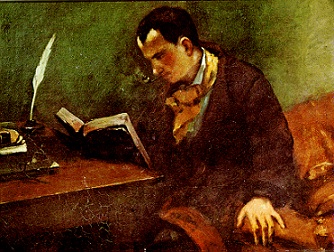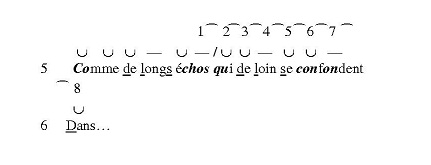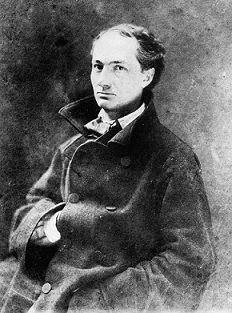This text was presented for the first time in a conference “Materializing Signs in Rhythm, Gravity and Figures” organized by Kristina Mendicino and Joachim Harst – Yale University, February 26-27, 2010. NOTE : This presentation is accompanied by a powerpoint .
[Slide 1] Quite legitimately, Walter Benjamin considers Baudelaire as one of the first witnesses both of the decline of the aura, which is specific to the works of art, and of the degradation of experience due to the life in the Great City. According to him, this situation accounts for the importance of the theme of the “correspondances” in Baudelaire’s poetry. “In order to account for what Baudelaire means by [this] word, he says, one could talk about an experience which develops without crisis. This experience is not possible but in the religious sphere.” Correspondences are ways to emancipate the subjectivity through a utopian love for the past. They are matter of recollection. Not matter of history but of prehistory. That is why they are linked to specific times of the social rhythm : “What makes the grandeur and importance of our holidays is that they make it possible to meet with an “anterior life””.
Still, Benjamin’s analysis could have developed further on. One may show, following Benjamin himself addressing the Baudelairean poetics of “shock” [1], that the “correspondances” are not only a poetic theme or a dream of an earlier rhythmic world. It actually begins with a rhythmic experience of the subject in language here and now. Before being projected into images and meanings, the Baudelairean experience is one of the signifiance in writing and reading.

Thus, by contending that ”one cannot find here any simultaneous “correspondances” like the ones that will be later promoted by the symbolists”, Benjamin misses probably something important and takes the enunciated as its face value without looking at what the enunciation does and whispers : “It is the past that whispers through the “correspondances” described by Baudelaire, he says”. Contrarily to this mystical reading of a mystical theme, one might find in Baudelaire’s poetry prosodic and rhythmic correspondences that weave l’écriture and create one personal rhythm which refers to present time.
[Slide 2] CORRESPONDANCES
La nature est un temple où de vivants piliersLaissent parfois sortir de confuses paroles ;
L’homme y passe à travers des forêts de symboles
Qui l’observent avec des regards familiers.
Comme de longs échos qui de loin se confondentDans une ténébreuse et profonde unité,
Vaste comme la nuit et comme la clarté,
Les parfums, les couleurs et les sons se répondent.
Il est des parfums frais comme des chairs d’enfants,Doux comme les hautbois, verts comme les prairies
– Et d’autres, corrompus, riches et triomphants,
Ayant l’expansion des choses infinies,Comme l’ambre, le musc, le benjoin et l’encens,
Qui chantent les transports de l’esprit et des sens.

[slide 3] One of the most striking features of this poem is the spreading, dissemination and return of the syllables that compose the title in the whole text. The signifiance produced by this organized dissemination reveals a subject which, while referring at the perfect rhythms of the lost world, affirms its power to transcend here and now the sinful and obscure nature through the power of imagination and poetic rhythms.
The syllable

makes its way through the first quatrain and the first tercet. It forms a long series in which the enunciation ties a dynamic bond between a fallen nature and the faculty of man to find again the analogies which structured the Creation before the Fall. When the second edition of Les Fleurs du Mal was published, Baudelaire, in a note about Wagner, quoted the two quatrains of his sonnet : “What would be really surprising would be that the sound could not suggest the color, that the colors could not give the idea of a melody, and that the sound and color would be unsuitable for communicating ideas ; indeed the things have always been expressing themselves through reciprocal analogy since the day God uttered the world as a complex and indivisible totality [2].”
[Slide 4] This series starts in a very remarkable way by making the sound /ε/ the copula of a double ontological definition. In lines 1 and 2, it affirms a religious conception of nature which is for God both his creation and his temple :
1 La nature est un temple où de vivants piliers
2 Laissent parfois sortir de confuses paroles ;
[Slide 5] However, when man enters on stage in lines 3 and 4, a prosodic proliferation starts :
3 L’homme y passe à travers des forêts de symboles
4 Qui l’observent avec des regards familiers.
[Slide 6] The second quatrain comprises few sounds of this type.
[Slide 7] But the proliferation starts again and becomes more pronounced in lines 9 and 10 where the associationist dynamics and the mutual translatability of the human sensations are introduced : perfumes, tactile sensations and colors, but also sounds, metaphorically represented by the “oboes” and related to the series by a counter-accent [3].

[Slide 8] The series ends in lines 11, 12, 13 and 14 with an increasing intensification and especially in the last one which sings the pleasures of body and soul.
[Slide 9] Thus two main zones of sound intensification appear. The prosody clearly reveals, through phonic proliferation and increase of the signifiance intensity, a continuity with the fallen nature but also a relation of transcendence of man over it. This transcendence is clearly linked to his sensibility and his analogical power.
[Slide 10] The same phenomenon of signifying marking through proliferation and accumulation occurs with

, whose prosodic flow also starts in a relatively discrete way in the first quatrain where the fundamental unintelligibility of the Word and the fallen nature is exposed :
2 Laissent parfois sortir de confuses paroles ;
[Slide 11] Then the sounds multiply in three successive lines where the interpenetration and reverberation of sensations are described :
5 Comme de longs échos qui de loin se confondent
6 Dans une ténébreuse et profonde unité,
[…]
8 Les parfums, les couleurs et les sons se répondent.
As in the previous series, the prosodic movement indicates through an increased intensity the possibility for human imagination to go beyond the unintelligibility of nature. As you know, imagination is for Baudelaire the “queen of all human faculties”. Thus the second quatrain refers to the moving forces of the poetic creation and makes it possible to associate spirituality and sensibility.
[Slide 12] Towards the end of the first tercet, the series finishes with the idea of a dynamics of human sensations springing bottom-up then in all directions :
– Et d’autres, corrompus, riches et triomphants
Ayant l’expansion des choses infinies,
[Slide 13] What started as an evocation of the mystery of the fallen nature ends once again with a glorification of man and of the pleasures he gets through his senses.
[Slide 14]

diffracts throughout a prosodic series that begins in line 1 with the religious and animated dimension of nature :
1 La nature est un temple où de vivants piliers
[Slide 15] This series rebounds in line 6 where the obscurity of nature is entangled with the synthetic power of human imagination, which will soon surmount it :
6 Dans une ténébreuse et profonde unité,
[Slide 16] Then it starts to proliferate, especially in the rhymes and enjambements, in the first tercet which is devoted to qualify the sensations and their analogical power by associating to them the ideas of childhood and victory :
9 Il est des parfums frais comme des chairs d’enfants
10 Doux comme les hautbois, verts comme les prairies
11 – Et d’autres, corrompus, riches et triomphants,
12 Ayant l’expansion des choses infinies,
[Slide 17] It finally saturates the last two lines of the poem which express the ecstasy of the soul and the senses :
13 Comme l’ambre, le musc, le benjoin et l’encens,
14 Qui chantent les transports de l’esprit et des sens.
[Slide 18] Once again an increasing prosodic profusion may be observed that leads from nature to the human faculties and to the pleasures of sensibility.
[Slide 19] Finally the series initiated by

irrigates the last 10 lines of the sonnet. After a relative discretion in the first quatrain [slide 20], the cascade starts flowing with a first “comme” (as/like) which is strongly stressed through its place at the beginning of line 4 and through its syntactic function which refers to “perfumes”, “colors” and “sounds of lines 7. But it also serves as pivot for the passage of the ontological propositions of the first quatrain to the claims concerning human sensations that are exposed in the following section.

In this line, the doublet “Comme de longs échos”, paired by the sounds

and by a mirroring position in the hemistich, associates the analogical operator “comme” to the theme of the “écho”. Thus the natural analogies, which according to Baudelaire were almost completely lost, are linked with what is for Baudelaire “the lyric word par excellence” [4], the linguistic operator of the analogical power of human imagination. This fundamental fact is underlined by an over-accentuation of the line which comprises not less than 6 counter-accents plus one which strides across the enjambement to the next line (noted here by the numbers 1 to 8) [5] . The words “comme” and “échos” are simultaneously connected to “confondent” which agglomerates, both in its sound structure and signified, the continuum between natural analogies and comparisons through speech.
[Slide 21] In the wake of this line, this prosodic series expands through a remarkable repetition of “comme” proclaiming in an incantatory manner the human power of analogy : “comme la nuit et comme la clarté”, “comme des chairs d’enfants”, “comme les hautbois”, “comme les prairies”, “comme l’ambre”. Only “corrompus” introduces a nuance of something rotting which is a discrete recall of the original fall but is immediately transcended by its association with “riche et triomphant”.
Here is the final distribution for

. [Slide 22]

[Slide 23] This first approach is certainly very insufficient but it already makes it possible to show that Baudelaire did not await the Symbolists to practice “the simultaneous correspondences” which Walter Benjamin denies him, nor to engage a quest for transformation of experience here and now [6]. For sure, as Benjamin suggests, there is in this poem a kind of nostalgia for an “immemorial past”, a pre-adamic model of “full experience” and “anterior life” that the senses and imagination could enable us to foresee. The first quatrain, in particular, represents nature as a reality degraded by sin, where man can only perceive in a confused way some echoes of the original Word.
However, two important poetic facts minimize a little the impact of this first viewpoint. On the one hand, the emphasis on the pleasures given by senses is so important in the rest of the composition that the interrogation about the lost paradise retreats into the background to the benefit of a celebration of “the ecstasy of the soul and senses”. Baudelaire devotes 10 lines out of 14 to this celebration and, last but not least, he makes it the clausula of his poem. A sensualism inherited from the 18th Century, which attributes a full moral dignity to the human sphere, counterbalances the romantic religiosity and the theology of the sin which are expressed in this first quatrain.
On the other hand, if the word “comme” is used as a flag to announce the capacity of man to escape his dereliction thanks to the synthetic power of imagination, he is not the only one to carry out “correspondances”. Actually, it is the whole language which weaves the analogies and supports by its associating capacity the imaginative power that gives to man the mean to extract himself out of fallen nature and to enjoy again a “full experience”. All the prosodic and rhythmic series, that I have analyzed, agglutinate around crucial points of the discours that celebrate the power of imagination and connect words often very distant from each other or separated by the syntax. In the final analysis, the real object of celebration of this poem is the poetic speech itself, because it intertwines sets of prosodic and rhythmic correspondences which are at the same time dispersed and relatively well organized. Poetry is a kind of speech that is characterized by an organized movement of the signifiance [7] . In a way —and its place as first sonnet in the collection seems to verify it— this poem can be read like a poetic manifesto that speaks in praise not of a “former life” nor of “whispering past” but of the power of language and of the present of speech.
If we now superimpose these two orientations, we clearly see that the Baudelairean objective to transcend the dereliction of “Flesh” and “Nature” by “Art” —the very famous : “You gave me your mud and I turned it into gold”— appears in a way that is different from Benjamin’s view. The analogical signifying force of language makes it possible for the body to extract itself out of its historical corruption. Thanks to its own synthetic aspect, it offers to man the possibility to create here and now a sphere —the art— in which “the ecstasy of the soul and senses” are no longer separate. Thus Baudelaire, like Proust later, doesn’t seek only to go back towards the plenitude of an earlier experience but he already proposes in present time an experiment of individuation which results in a dissemination-organization of signifying networks in the language and in an anti-religious celebration of the powers of the body. In addition, he does not only open a way for the imprisoned experience ; he gives also to it a voice, it embroiders it in a rhythmic fabric which will enable it to circulate through time and people. Poems are —do we have to recall it ?— intended to be read, i.e. to create their readers and their public. And, as you know, that will prove to be very difficult for Baudelaire.
If we give to the term “rhythm” the pre-Plato meaning of “way of flowing”, or “organization of something moving” , we may thus say that according to Baudelaire poems, or more generally speaking poetry, seek to give “rhythms” to the language which allows their author to reform his or her experience and give the reader the power to fight against the dominant forms of life of the time. For example the forms related to the rise of the press, the urban development, and an increasing commoditization. Less than a will to regress into a prehistory that would be, as Benjamin would put it, “out” or “before the time”, poetry is an attempt to take control over it by being both subject and transsubject, at the same time present and transtemporal. Poetry is about taking advantage of the general de-rhythmization of life to create through language new rhythms or new forms of life, that are at the same time strictly personal but completely shareable by other people. It is about mutually creating individuals and a public composed of individuals, a true democracy of poetry. To put it in a nutshell, Walter Benjamin’s critique of Baudelaire is still too much influenced by theology and tends to forget the “politization of art” that Benjamin himself has helped us to understand.
Concerned by the new forms of social interaction in the “enormous cities”, by “the entanglement of their innumerable relations” and the vast number of shocks that they continuously produce, concerned by a de-rhythmized society that spreads in fluid and chaotic ways in streets and boulevards, concerned by an experience that is more and more degraded and that will be soon mechanized, Baudelaire invents a new kind of poetry which must simultaneously enable him to represent those new features of modern world and to oppose them through a “personal prosody”, a poetic rhythm, which reinstalls the conditions for a full experience and enables other people to fight back.
CORRESPONDENCES
Nature is a temple in which living pillarsSometimes give voice to confused words ;
Man passes there through forests of symbols
Which look at him with understanding eyes.
Like prolonged echoes mingling in the distanceIn a deep and tenebrous unity,
Vast as the dark of night and as the light of day,
Perfumes, sounds, and colors correspond.
There are perfumes as cool as the flesh of children,Sweet as oboes, green as meadows
— And others are corrupt, and rich, triumphant,
With power to expand into infinity,Like amber and incense, musk, benzoin,
That sing the ecstasy of the soul and senses.
(Trans. William Aggeler, Fresno, CA : Academy Library Guild, 1954)
CORRESPONDENCES
Nature is a temple, where the livingColumns sometimes breathe confusing speech ;
Man walks within these groves of symbols, each
Of which regards him as a kindred thing.
As the long echoes, shadowy, profound,Heard from afar, blend in a unity,
Vast as the night, as sunlighťs clarity,
So perfumes, colours, sounds may correspond.
Odours there are, fresh as a baby’s skin,Mellow as oboes, green as meadow grass,
— Others corrupted, rich, triumphant, full,
Having dimensions infinitely vast,Frankincense, musk, ambergris, benjamin,
Singing the senses’ rapture, and the soul’s.
(Transl. James McGowan, Oxford : Oxford Univ. Press, 1993)


